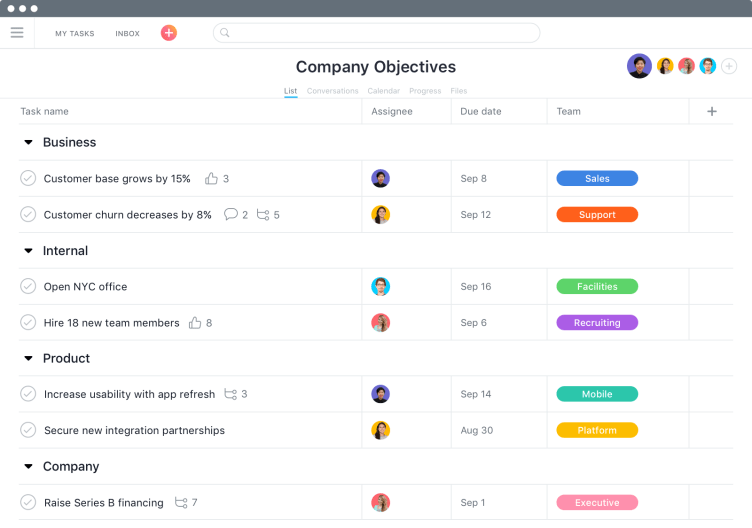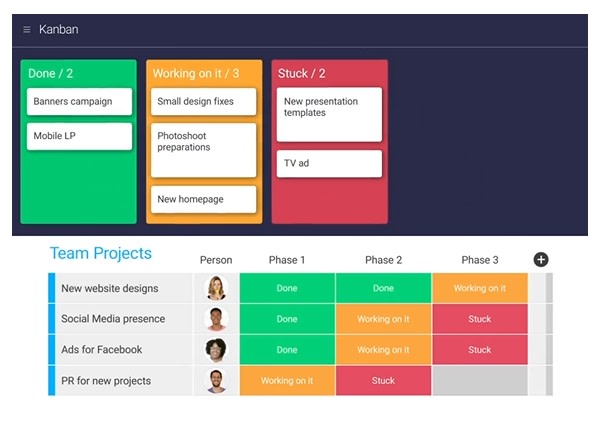monday reviews is our latest blog series where we provide the facts about different project management tools—no BS and no hyperbole needed. Keep scrolling for our analysis and to learn more about all the project management tools out there. Enjoy! 😊
When you’re looking for the right project management software for your team, there are lots of factors to consider.
Apart from cost, you’re looking for things like easy file sharing, scheduling features, and features that will simplify teamwork and collaboration, right?
Unfortunately, choosing a project management tool is kind of like being in the yogurt aisle — there are so many choices you could freeze to death.
So we tend to jump to the big names, like Asana, or monday.com as a completely random example…
But does Asana’s project management platform tick all the right boxes for your specific needs?
In this article, we’ll take a deep dive into Asana’s project management tool and how monday.com compares as an alternative.
What is Asana?
Asana was founded in 2008 by Facebook co-founder Dustin Moskovitz as well as ex-Facebook engineer Justin Rosenstein as an internal tool within Facebook to “help everyone track their work.”
Simply put, it’s a project management tool, mostly focused on team communication and collaboration.
Asana project management features:
Asana project management features are designed to help small and medium-sized businesses in their task and workflow management.
Let’s dive in and look at some key features.
Task management
Asana offers a streamlined way of managing your project by helping you plan and organize your tasks, whether they’re individual tasks or part of recurring tasks in a complex project.
For those of us who are not developers or ultra-tech savvy, Asana has a cleaner and minimalistic interface.
Asana offers a feature called Workload, which lets you track how much work each team member currently has on their plate and prevents burnout by letting you set restrictions on their workloads. P.S. — we have a workload view too, and more! 🙂
You can attach a file or add a comment using @ mentions to alert team members, both on Asana and monday.com.

Asana pricing
- Basic – for individuals or teams of less than 15, Asana offers their most basic plan for free “forever,” and includes unlimited storage, access to its iOS and Android mobile apps, and unlimited projects and tasks
- Premium – their premium plans cost $10.99 per user per month, and grants access to forms, dashboards, and inviting unlimited free guests
- Business – Asana’s business plan sets teams back $24.99 per user per month, offering advanced integrations with Salesforce and Adobe, and customizing forms
- Enterprise – there aren’t huge differences between the business and enterprise plans, except that the Enterprise plan includes User provisioning & de-provisioning (SCIM) and priority support, but the cost is not listed on their website.
Asana customer support: can’t talk, just email
Here at monday.com, we take our customer support VERY seriously, which is why we’re dedicating a whole paragraph to it here, and also guarantee our customers 24/7 support, every day of the year! Also, our incredible customer success team has an average response time of less than 60 minutes! Not to brag or anything…
No one likes being put on hold for hours on end, or hearing the dreadful music often associated with it. That being said, Asana does offer an email and chat support option, with a caveat—only customers who subscribe to its Premium, Business, or Enterprise accounts. To our knowledge, Asana does not offer any phone support.
But, every business’ workflow needs are different. Yours might need more customization and data visualization features than Asana offers.
Asana integrations: including an integration with monday.com
Asana has a wide array of integrations to choose from, including Slack, GitHub, Excel, Jira Cloud, and even a monday.com integration. That being said, Asana’s integrations with GitHub and other software development tools are not as comprehensive as Jira’s, and could use an upgrade.
Asana customer reviews: 4.3 / 5 on G2
On software comparison and reviews site G2, Asana garnered a 4.3 / 5 ranking from 6,836 reviews and counting. Asana touts having more than 80,000 paying teams, so it’s unsurprising that there are a lot of reviews.
This begs the question, is there an Asana alternative to consider?
monday.com might be just the ticket.
So, how does monday.com compare?
monday.com is a comprehensive Work OS that helps teams to plan, organize, and track their work.
It boosts team collaboration and communication by helping you streamline multiple projects, manage teams, and track progress at every stage.
What is a Work OS, you ask?
TL;DR – it’s much more than a project management or management app, it is customizable and helps you build (almost) anything you could dream up for your project management needs in real-time.
A work operating system (Work OS) is a cloud-based software platform where teams create custom workflow apps to plan, run, and track processes, projects, and everyday work.
With a work OS, every team can create the apps it needs for everyday work. And when several teams in an organization use a work OS, they can achieve even more together.
A Work OS becomes a digital workspace within an organization: its building blocks can be assembled into apps that manage any kind of work. It collects information from external tools, helps teams communicate about items within the context of the work happening, and places all workflows in one place. This creates a centralized home for all work.
What are the key features of monday.com?
This includes features to promote team collaboration, document sharing, visual boards, task delegation, budget management, and analytics reporting.

Here’s a look at what our visual platform offers:
- Easy-to-use, visual interface so you can start seeing results INSTANTLY
- Hundreds of ready-made templates
- 8 different visual workflows, inlcuding Gantt charts, Kanban board, calendar view, and more!
- Create, customize, and share forms with your team members and clients
- 40+ high-quality integrations — both for developers and non-developers alike
- Custom workflow automation to automate the mundane tasks, notifications, and even emails (no coding required!)
Don’t just take our word for it: monday.com has a rating of 4.6 /5 on G2 from more than 1,200 users. In fact, more than 7,000 people ranked monday.com 4.6/5 or above on review sites, including G2, Capterra, Trustpilot, TrustRadius, and GetApp.
How does monday.com compare to Asana pricing?
With monday.com you can choose your plan depending on whether you have a small team seeking basic functionality or are a large scale organization looking for the entire gamut of features and custom fields.
The costs also vary depending on the number of users you’d like to sign up for and whether you’d prefer monthly or annual billing.
To play around with the options and see the perfect pricing plan for your team, take a hop over to our pricing page.
Still undecided? Why not give monday.com’s customizable project tracker template a go and see how it does the work for you.
Learn how to manage your project, your way with monday.com


